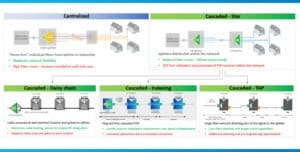Bridging the Digital Divide with BEAD

Author: Craig Culwell, Director, Market Development, Network Cable & Connectivity, CommScope
Bridging the digital divide will continue to be a major theme as we head into 2023, and there is still a lot of work to be done. According to government data reported by the Federal Communications Commission (FCC), in 2021, over 10 million Americans lacked sufficient access to high-speed internet. In today’s digital world, a high-speed internet connection is essential for many tasks, like remote working, telehealth and online learning. As many now view the internet to be as necessary as any utility – in the same way we would water, gas, and electricity – it’s time for us to connect the unconnected.
This is no small feat, networks are under constant pressure to cope with increasing demand, while evolving alongside new technologies and remaining flexible for further expansion. It’s critical that everyone across the world has the same access to the opportunities brought about by broadband connectivity. Closing the digital divide will be taking a vital step in facilitating the delivery of a wide range of services and applications to improve business efficiency and productivity – as well as enhancing everyday lives.
As we look towards 2023, network providers will continue to work closely with government agencies to close this gap. We’re already seeing huge funding pots allocated from various governments and agencies around the world. This investment in digital transformation and infrastructure will provide long term and far-reaching benefits for us all – both economically and socially. The Broadband Equity, Access, and Deployment (BEAD) Program offers one of the most significant opportunities for states and network providers to work together to make broadband for everyone a reality. BEAD prioritizes bringing high-speed internet connections to underserved locations with no access and upgrading locations with limited access – with a focus improving communities, organizations and bringing Wi-Fi to multi-unit residential buildings.
In the past year, widespread geopolitical trends have had an outsized effect on the growth of broadband networks. Supply chain, skilled labor, and logistical constraints have limited the speed of network deployments—but now, unprecedented government funding, and a mature crop of network technologies will yield a steep demand curve for building next generation networks—setting the stage for extraordinary capacity expansion.
This expansion creates new opportunity but also new challenges in determining the best path to connectivity—whether that’s achieved through fiber deep upgrades to cable networks like Hybrid Fiber-Coax (HFC) to enable DOCSIS 4.0, or placement of passive optical network (PON) optical line terminal (OLT) in a remote node, utilizing the reach of fixed wireless access (FWA) technologies, overbuilding telco networks like Digital Subscriber Line (DSL) and harnessing the innate efficiencies of multi-gigabit fiber technologies like passive optical networks (PON), or a combination. At the heart of all these broadband technologies is fiber.
The goal is certainly for fiber all the way to the home, whether home is at a farm, in a suburb, a condominium or an apartment complex. Different serving environments and housing densities, for example urban versus rural, will necessitate different fiber access network architectures and well as different wireless distribution to be most efficient in connecting devices and users. Below are examples of FTTH network topology choices:
FTTH Network Topology Choices

The above focuses on fiber services to single-family units (SFUs); however, an increasingly large portion of the world’s population lives in multi-dwelling units (MDUs). When it comes to fiber infrastructure for MDUs, space and labor-saving solutions are critical, in not just bringing the broadband to the residence, but also in distributing it cost effectively while ensuring great performance. This is where CommScope’s innovative solutions will enable rapid deployment of fiber from the building entrance, and then leverage managed Wi-Fi to provide efficient radio frequency (RF) distribution and interference mitigation while ensuring high-performance broadband throughout a densely populated MDU.
Depending on several factors, wireless technologies can be leveraged to complement the fiber deployments, often by extending fibers capacities to the last few hundred feet. This was demonstrated in various digital divide initiatives that took place at the beginning of the pandemic to help school children with remote learning. In Oakland and San Jose, California, RUCKUS Wi-Fi was utilized as an FWA option, where the fiber capacity was distributed on a street light pole throughout a neighborhood allowing for a faster and more cost-effective method of the fiber broadband distribution. In addition, RUCKUS CBRS was used to support distance learning in Murray, Utah, and to support COVID triage centers in Durham, North Carolina, and Chicago, Illinois.
While we saw some momentum in building our fiber networks in 2022 in these types of initiatives, the current economic condition is creating a slowdown in this type of investment. The BEAD program provides a means to invigorate fiber build plans, generate positive financial returns, and enable the path to broadband for everyone. The BEAD program provides $42.5B in government funding to help fast-track broadband network deployments. These funds are the catalyst that can help states, municipalities and network providers make broadband for everyone a reality.
The BEAD Success Summit produced by the Telecommunications Industry Association (TIA) will bring together government and industry leaders to discuss, the BEAD program requirements and various network architecture alternatives. As a long-standing member of the TIA, CommScope is committed to providing resources and expertise to the states and municipalities to support their broadband build out goals.
CommScope’s Broadband for Everyone Accelerate Program (BEAP) can help maximize these opportunities and get the most out of every dollar with a range of full project lifecycle support offerings that include budgeting, grant application, network planning and design, training, and more. Not sure which funding is appropriate for a given project? CommScope can provide the expertise and resources to help choose the right government funding programs and navigate the application process.
While broadband for everyone is an ambitious goal, it is achievable. One of the first steps of the journey is for all eco-system partners to recognize the challenges, opportunities, and economic realities of network deployment in underserved markets. CommScope is committed to the success of the BEAD Program and to help bridge the digital divide.
The ideas and views expressed in this guest blog article are those of the author and not necessarily those of TIA or its members companies. Commscope is a sponsor of the TIA BEAD Success Summit. TIA is technology and company neutral and does not endorse any one product, approach, or company over any others.
